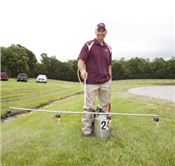|
Fighting Resistance

“Curse or cure”. Ron Krausz, researcher and farm manager at the
Belleville Research Center for SIU Carbondale, spoke of advantages
and disadvantages of the new Enlist and Dicamba soybeans.
Photo by John LaRose, Jr.
New Soybean Traits, Herbicides Provide Better Weed Control
BETTY VALLE GEGG-NAEGER
MidAmerica Farmer Grower
BELLEVILLE, ILL.
Advantages and disadvantages of the new Enlist soybeans and Dicamba soybeans were presented by Ron Krausz, researcher and farm manager at the Belleville Research Center for SIU Carbondale, recently.
“The sentiments right now in the country as this technology becomes available is whether it’s a cure or a curse,” he began. “So today I’m talking to growers about some of the benefits of this new technology and possibly some of the disadvantages.”
A new technology can actually be a cure because there are a lot of resistant weeds now in the state of Illinois, such as marestail, Palmer amaranth, and common waterhemp. In that respect the new technology actually could be a cure for the weed problems a lot of growers in southern Illinois experience.
On the other hand, the herbicides that come along with this technology have specific restrictions on the label on the use of these herbicides. Some of them are triple rinsing, making sure that the wind speed is not too high, using the right nozzles, and switching from small droplets to large droplets for contact herbicides to prevent the possibility of drift.
“The weed control with these new technologies can control the weeds that we’re trying to control that may be resistant,” Krausz continued. “However with this technology, we’re still shooting for small weeds, weeds that are six inches or less, preferably four inches or less. If we use a soil herbicide and apply these new herbicides post emergence at the right weed size we should be able to get very good weed control.”
His take-home message for the growers when using this new technology is to be sure to read and follow the label, and be sure that you apply a soil herbicide followed by these new herbicides and make sure weeds are small at the post emergence application.
“If you do all these things these new soybean herbicide traits and their herbicides are very effective,” he said.
“These new products should be used on weeds that are six inches or less, preferably four inches or less. They are not like the early days with glyphosate products, when growers were controlling weeds that were a foot tall or taller. With the new herbicide traits, we want to make sure that we’re focusing on small weeds to be effective. Otherwise resistance will develop to these new herbicides that partner with these new soybean herbicide traits.”
Krausz reports very good results with the new herbicide traits and their herbicides. He also noted only a very minor or no drift problem, because the application requirements on the labels were followed.
“These new herbicide traits and their herbicides are not interchangeable,” he stressed. “You cannot use herbicides that are listed for Enlist soybeans on Dicamba soybeans and vice versa.”
Krausz displayed a spraying apparatus, and demonstrated to growers the differences in the nozzles.
“The new herbicides on the labels will have specific nozzles that must be used with that particular herbicide and with this device I’m showing a large droplet nozzle versus a small droplet nozzle. With the new herbicides we’re going to be using nozzles that create larger droplets because larger droplets fall faster, they evaporate slower, and they’re just less prone to drift.”
One nozzle was a TTI air induction nozzle. It actually has an air port on it that inducts air into the solution that makes large droplets, making it less prone to drift.
“The other nozzles we currently use for most of our herbicides, post herbicides and soil herbicides, they are flat fans,” he explained. “It produces a lot smaller droplet because we are using contact herbicides and to get contact herbicides to be effective you need to have very good coverage. In our research though we’re finding that even using contact herbicides with the TTI nozzle we’re not seeing a difference in control on these weed species even though the herbicide may be a contact herbicide.”
In a new development, this week Monsanto received China import approval for dicamba-tolerant soybean, Krausz reported
“In research at SIU, soybean yield of dicamba-tolerant soybean has been comparable to soybean yield of Roundup Ready 2 Yield soybean,” he said.
Yet, despite the China import approval of dicamba-tolerant soybean, the U.S. EPA has not approved the registration of the new herbicides which are to be used with the dicamba-tolerant soybean system.
“Therefore, dicamba cannot be used preemergence or postemergence in dicamba-tolerant soybean until U.S. EPA approval is given,” he said. ∆
BETTY VALLE GEGG-NAEGER: Senior Staff Writer, MidAmerica Farmer Grower
|
|